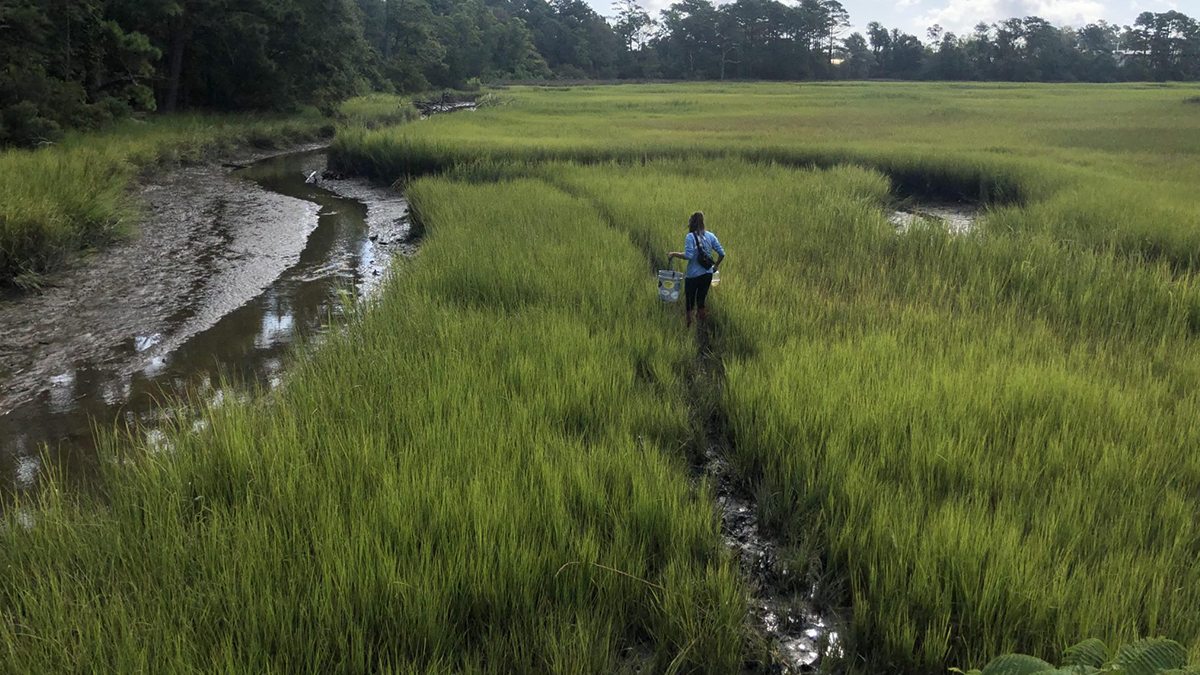Urban habitats lessen coastal flooding impacts
Lawns and stormwater ponds remove nitrogen and improve water quality, a Carolina study says.

As climate change continues, some storm models are predicting an increase in hurricane intensity and an increase in precipitation, causing flooding and devastating coastal communities, water quality and daily life.
A new study by researchers at UNC-Chapel Hill assessed water quality regulation by flooded landscapes in the upper Neuse River Estuary along the North Carolina coast. They found urban estuarine habitats to be effective at permanently removing nitrogen through denitrification — a natural process that improves water quality.
“Urban landscapes like lawns and stormwater ponds are becoming more common as coastlines develop, so understanding the role they play in maintaining water quality is increasingly important,” said Anne Smiley, lead researcher and doctoral student in the College of Arts and Sciences’ earth, marine and environmental sciences department. Smiley also belongs to the Piehler Lab.
“Coastal landscapes are a patchwork of natural habitats, like marshes and forests, and urban habitats. Denitrification capacity and distributions of these landscapes within a floodplain can influence water quality regulation capacity at the watershed scale. As coastal development continues, it is important to understand the beneficial functions of urban landscapes, like lawns and stormwater ponds, as well as the functioning of natural habitats, like marshes, in the context of a built environment,” Smiley said.
Previous studies have documented effective denitrification in wetlands and oyster reefs, but this study focused on urban and natural landscape elements, such as stormwater ponds, undeveloped open space, forested wetlands and subtidal sediment. It also accounted for different storm characteristics such as high-speed sustained winds or high amounts of rainfall, which affect the water chemistry differently. The team used data from 37 hurricanes that affected the study region ranging from 1996 to 2019.
The results of the study, published in Natural Hazards and Earth System Sciences, an EGUsphere journal, show that both urban landscapes and natural habitats play an important role in regulating water quality during flooding events, although nitrogen is processed differently due to storm characteristics.
Storm characteristics, habitat type and habitat coverage within a storm’s floodplain influence overall contribution to nitrogen removal. Flooded landscapes were less effective at removing nitrogen during high-wind, high-precipitation events. In general, natural habitats like marshes and swamp forests were more effective at removing nitrogen than urban habitats like lawns and stormwater ponds.
Although the importance of these urban habitats cannot be discounted, the stormwater pond sampled in this study was part of a restored wetland and likely removes a considerable amount of nitrogen during low-precipitation and low-wind storm events. Swamp forests, an abundant floodplain habitat, made the largest contribution to removing nitrogen from the water during every type of storm, making them a valuable habitat for maintaining water quality.
“These differences in processing suggest that abundance and spatial distributions of these habitats within a floodplain can influence overall nitrogen removal capacity at the watershed scale,” said Smiley. “Understanding nitrogen removal capabilities and limitations of flooded natural coastal habitats as well as those urban landscapes that will become more and more prevalent, will enable us to make informed management decisions to benefit the integrity of our coastal waters.”
“Anne’s work has advanced our understanding of the value of natural systems like marshes in urbanized areas,” said Mike Piehler, a co-author and professor, director of the UNC Institute for the Environment and chief sustainability officer at Carolina. “This information is already informing land use decisions in North Carolina’s coastal communities and has broad application beyond our state. I am so excited for Anne to have this great paper from her dissertation published in an excellent journal.”
Read the full paper in Natural Hazards and Earth System Sciences.







